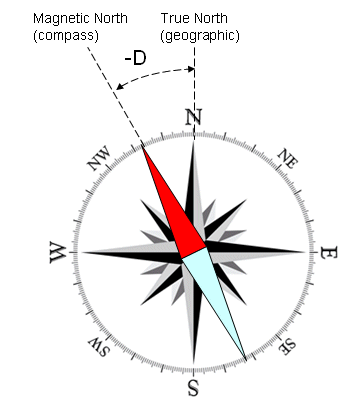
What is magnetic declination?
Answer
487.2k+ views
Hint: Magnetic declination is the angle on the horizontal plane between magnetic north and true north. As the time passes, magnetic declination varies both from place to place. It depends on how far away the magnetic poles are.
Complete step by step answer:

The direction in which the compass needle points is known as Magnetic North. Angle between this magnetic north and the True North direction is called magnetic declination. As the time passes, magnetic declination varies both from place to place. The magnetic declination in a given area will change slowly as time moves, like 20-25 degrees per year only. The rate of change is very small. It depends on how far away the magnetic poles are. There is Complex fluid motion in the outer core of the Earth which causes the magnetic field to change slowly with time. This change is called secular variation. If the compass at the place is pointing clockwise with respect to the True North, then the declination is positive or EAST. If the compass at the place is pointing counter-clockwise with respect to the True North, then the declination is negative or WEST. So this is the magnetic declination and it is also known as magnetic variation.
Note:
The magnetic declination is also known as magnetic variation. So don’t get confused. Magnetic declination is the angle between magnetic north and true north. The magnetic variation is seen as the time moves or the location changes. Now let us look at how to calculate magnetic declination. Convergence angle is the angle between grid north and true north. To obtain the true declination it is needed to add or subtract the convergence angle to the Grid Declination. So to find the true inclination, convergence angle is necessary.
Complete step by step answer:

The direction in which the compass needle points is known as Magnetic North. Angle between this magnetic north and the True North direction is called magnetic declination. As the time passes, magnetic declination varies both from place to place. The magnetic declination in a given area will change slowly as time moves, like 20-25 degrees per year only. The rate of change is very small. It depends on how far away the magnetic poles are. There is Complex fluid motion in the outer core of the Earth which causes the magnetic field to change slowly with time. This change is called secular variation. If the compass at the place is pointing clockwise with respect to the True North, then the declination is positive or EAST. If the compass at the place is pointing counter-clockwise with respect to the True North, then the declination is negative or WEST. So this is the magnetic declination and it is also known as magnetic variation.
Note:
The magnetic declination is also known as magnetic variation. So don’t get confused. Magnetic declination is the angle between magnetic north and true north. The magnetic variation is seen as the time moves or the location changes. Now let us look at how to calculate magnetic declination. Convergence angle is the angle between grid north and true north. To obtain the true declination it is needed to add or subtract the convergence angle to the Grid Declination. So to find the true inclination, convergence angle is necessary.
Recently Updated Pages
Master Class 12 Economics: Engaging Questions & Answers for Success

Master Class 12 Maths: Engaging Questions & Answers for Success

Master Class 12 Biology: Engaging Questions & Answers for Success

Master Class 12 Physics: Engaging Questions & Answers for Success

Master Class 12 Business Studies: Engaging Questions & Answers for Success

Master Class 12 English: Engaging Questions & Answers for Success

Trending doubts
Which are the Top 10 Largest Countries of the World?

Differentiate between homogeneous and heterogeneous class 12 chemistry CBSE

What is a transformer Explain the principle construction class 12 physics CBSE

Draw a labelled sketch of the human eye class 12 physics CBSE

What are the major means of transport Explain each class 12 social science CBSE

What is the Full Form of PVC, PET, HDPE, LDPE, PP and PS ?




